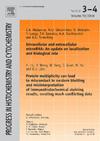Modelling the metastatic cascade by in vitro microfluidic platforms
Q Medicine
引用次数: 44
Abstract
The metastatic cascade comprises the following steps in sequential manner: the future metastatic cell has to leave the primary tumor mass, degrade the surrounding extracellular matrix, extravasate and circulate within in the bloodstream. Thereafter it has to attach to the endothelium of a target organ, intravasate into the connective tissue and has to proliferate to form a clinically detectable metastasis. We overview the in vitro microfluidic platforms modelling the metastatic cascade and the evolution towards systems capable of recapitulating all the steps by a single comprehensive model.
用体外微流控平台模拟转移级联
转移级联包括以下步骤:未来的转移细胞必须离开原发肿瘤肿块,降解周围的细胞外基质,外渗并在血液中循环。此后,它必须附着在靶器官的内皮上,通过血管内渗进入结缔组织,并必须增殖以形成临床可检测的转移。我们概述了模拟转移级联的体外微流控平台和向能够通过单一综合模型概括所有步骤的系统的演变。
本文章由计算机程序翻译,如有差异,请以英文原文为准。
求助全文
约1分钟内获得全文
求助全文
来源期刊
CiteScore
4.67
自引率
0.00%
发文量
0
审稿时长
>12 weeks
期刊介绍:
Progress in Histochemistry and Cytochemistry publishes comprehensive and analytical reviews within the entire field of histochemistry and cytochemistry. Methodological contributions as well as papers in the fields of applied histo- and cytochemistry (e.g. cell biology, pathology, clinical disciplines) will be accepted.

 求助内容:
求助内容: 应助结果提醒方式:
应助结果提醒方式:


